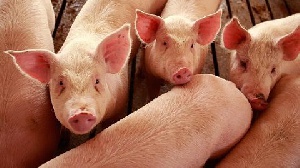By George Sydney Abugri
Ghana has more than 90 lagoons along the 550 kilometre stretch of the country’s coastline. The longest and largest of Ghana’s lagoons is the Keta Lagoon which is 126.13 km in length.
Lagoons play the vital environmental role of supporting a balance in the ecology, as the water bodies are home to many forms of aquatic life, and their vicinities home to many kinds of birds, plants and animals. Just as importantly, lagoons are a source of livelihood for coastal fishing communities.
Unfortunately most of Ghana’s lagoons are fast dying: The Chemu lagoon used to be a major source of livelihood for people in the lagoon area before the lands were acquired by the government through a legislative instrument in 1951, for the building of the city of Tema and the Tema Harbour.
The people of Tema used to harvest tilapia, crabs, shrimps and fish from the Lagoon. Boating was a popular sport on the lagoon. Today, the lagoon is choked with human waste and effluence from the industries.
The pollution of the Chemu lagoon has been blamed partly on human activity around the catchment area of the lagoon and the discharge of industrial affluence and waste from factories and industries in the port city.
While some of the industries treat their effluence before discharge, others discharge raw, untreated waste into the lagoon, polluting the water body and killing aquatic life.
The Canter for Public Interest Law dragged the Tema Oil Refinery to court several years ago on behalf of people of Tema Manhean, for polluting the lagoon. The pollution of the Chemu Lagoon by the defendant company, the center argued, was hazardous to the health of the citizens of Ghana and especially communities along the banks of the lagoon.
The plaintiffs contended that the persistent pollution of the lagoon by the refinery had made the inhabitants of Tema Manhean, who are predominantly fishermen, destitute as they could no longer earn a living from fishing in the lagoon due to the massive destruction of all life forms in the water body.
The court ruled in favour of the community but little was done to clean the lagoon of the pollutants from the refinery.
The Fosu Lagoon which has been a source of livelihood for fishermen and a source of fish for the people of Cape Coast for many years, has been so threatened by pollution, that the Environmental Protection Agency has had occasion to warn residents of Cape Coast to stop eating fish from the lagoon.
Not long ago, the Agency asked fishermen to stop fishing activities in the lagoon until the health of the highly silted water body had been restored.
The pollution of the Fosu Lagoon has been blamed partly on the discharge of large volumes of liquid and solid waste from a disposal site at Nkanfoah in Cape Coast.
Additional waste, oil and metal scrap from garages at Siwdu, waste from palm kernel extraction and processing around Adisadel Village and free-range defecation in the catchment area of the lagoon, have all contributed to the high level of contamination and pollution of the Fosu Lagoon.
Then there is the Korle Lagoon in Accra: Environmentalists agree that the Korle Lagoon is one of the most polluted water bodies on earth. Most of the industrial and human waste of Accra is washed into the lagoon.
Due to very high levels of toxic pollution, no living organisms, plants or animals cannot grow in the lagoon. Like the Chemu Lagoon, it is dead. In the words of one environmental journalist “even boaters steer clear of the lagoon’s thick, black nauseating syrup. Its stench wafts back to envelop the adjoining shantytown that is home to hundreds of families who, because they have no sanitation facilities, have turned the shores of the lagoon into a giant latrine.”
The Kpeshi Lagoon is no better: the lagoon, once a source for fresh fish and salt, has for year now been choked with rubbish and plastic waste. Pollution especially from plastic waste has affected both livestock and human health in the community.
The Keta Lagoon is the largest of Ghana’s over 90 lagoons. It is separated from the Gulf of Guinea by a narrow strip of sandbar and is surrounded by flood plains and mangrove swamps.
The lagoon is surrounded by many settlements. The towns include Anloga, Woe, Keta and Kedzi to the south, Anyako and Anlo Afiadenyigba to the north, Kodzi, Alakple and Tregui to the west and Denu and Adina to the east.
The lagoon became part of the daily existence of the people of Anlo land. In 1992 the Keta Lagoon was placed on the list of Wetlands of International Importance by the Ramsar Convention on Wetlands, to ensure its conservation and protection.
Today, thanks to over population growth, extensive human activities and climate change, the lagoon is polluted and appears to be drying up.
Environmentalists say the natural habitat of fishes in the water body has been degraded and this has caused changes in the size and structure of fishes from the lagoon as well as species composition of the catches fishermen land.
Fishermen also now tend to use smaller, mesh nets in fishing and this has led to the depletion of regenerative fish stocks.
Many more are the lagoons that are threatened. While environmentalists agree that he cost of restoring the countries lagoons back to aquatic life will be colossal it is necessary for the restoration and conservation of the lagoons and the protection of the livelihood of coastal communities.
.
Opinions of Sunday, 25 September 2016
Columnist: Abugri, George Sydney


















